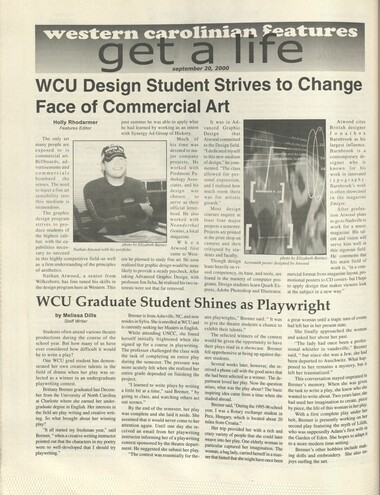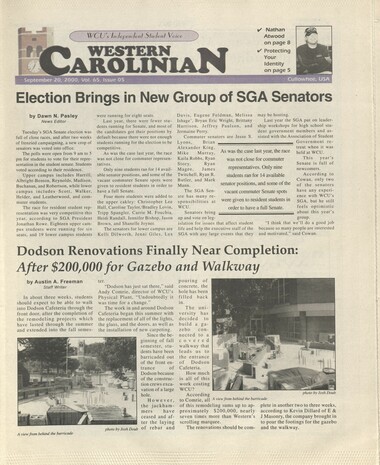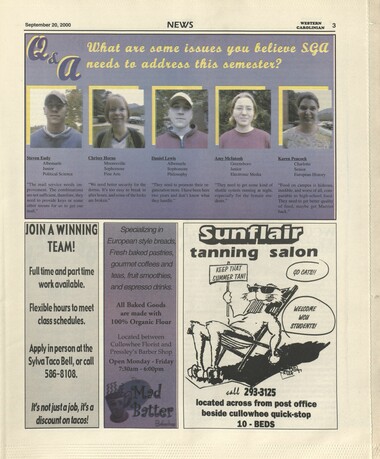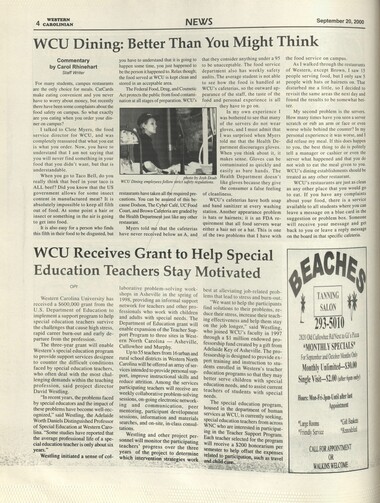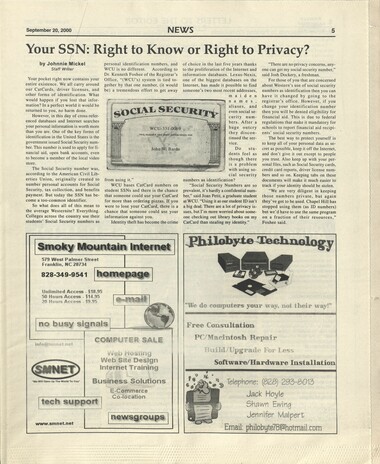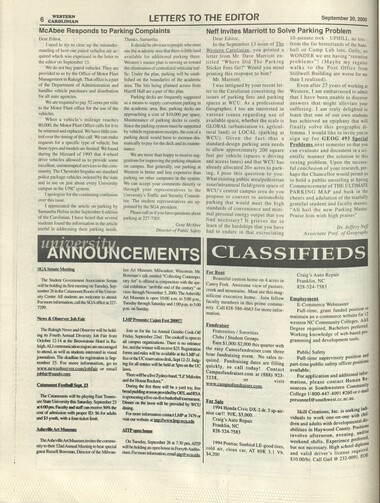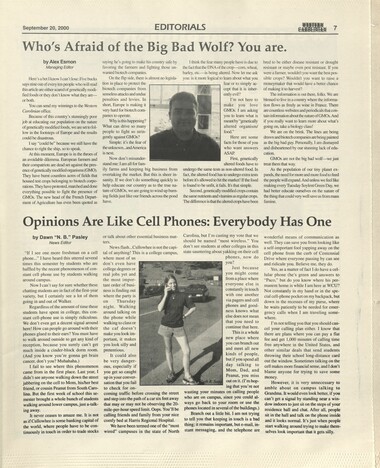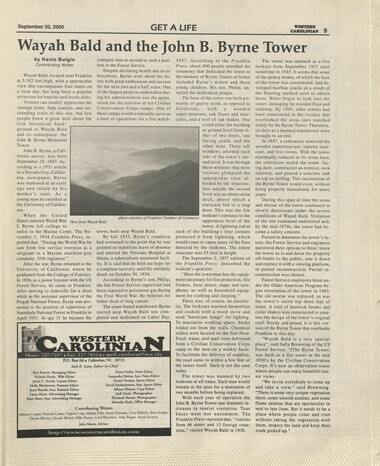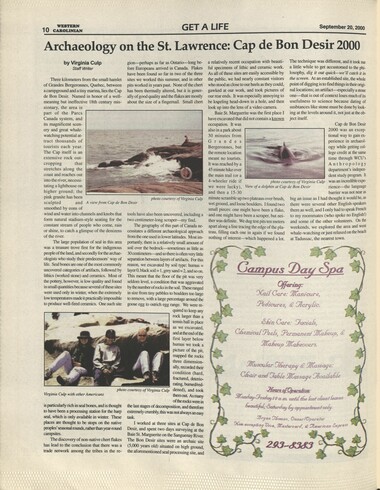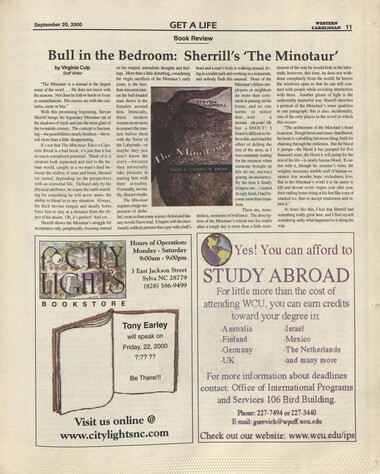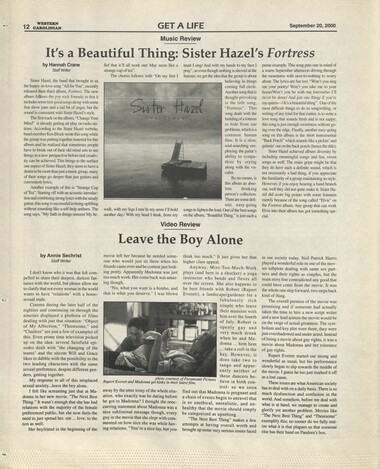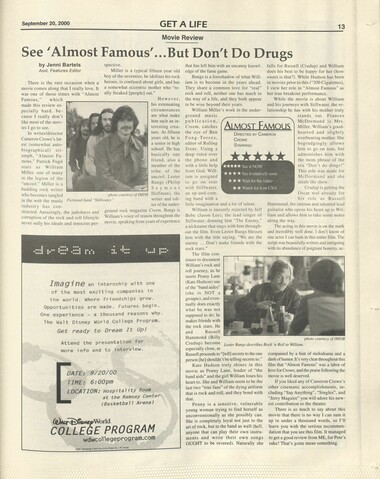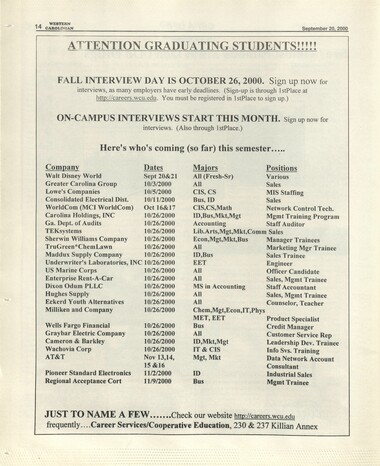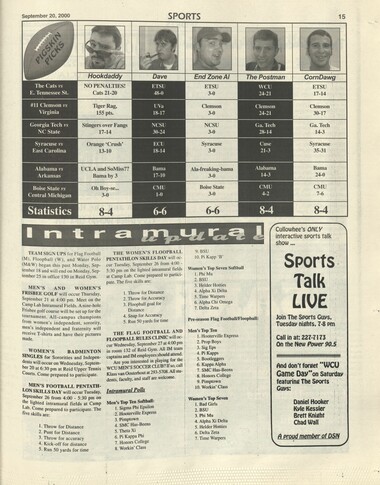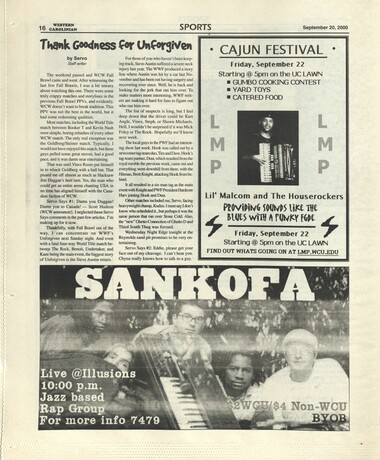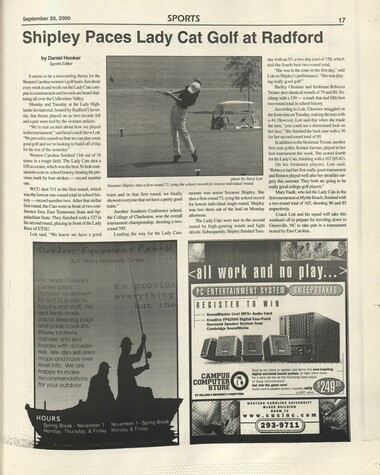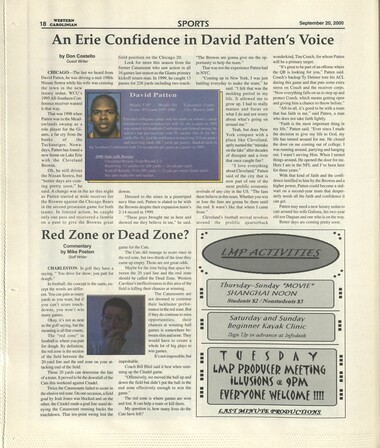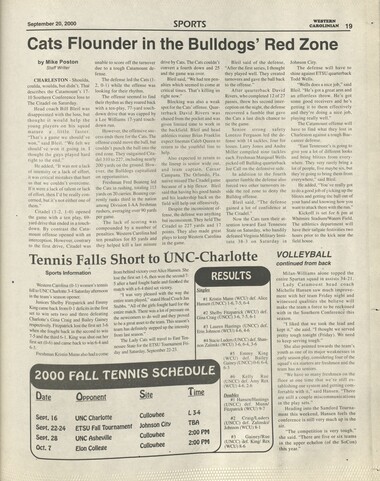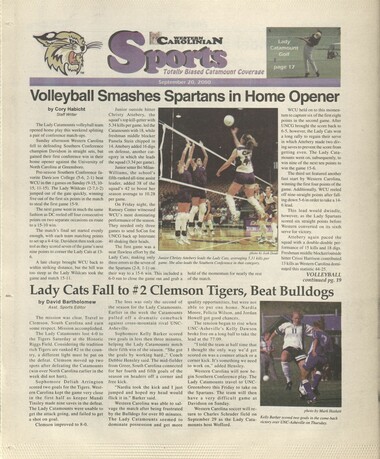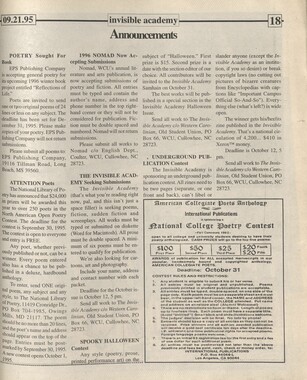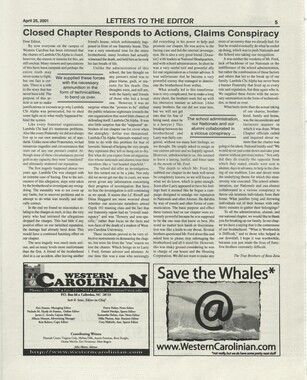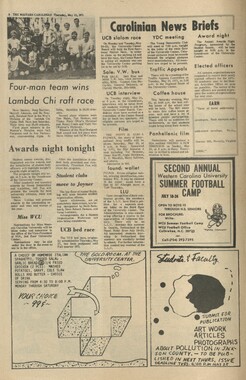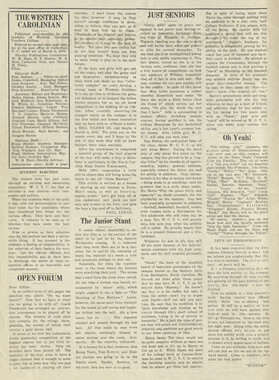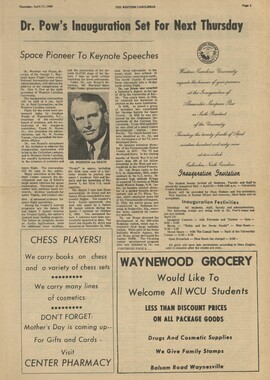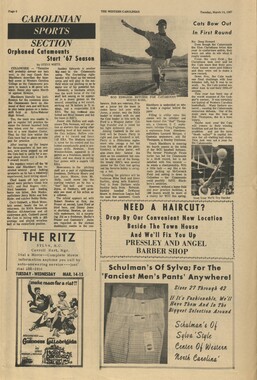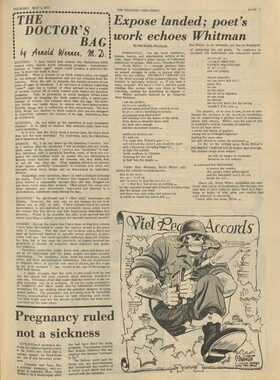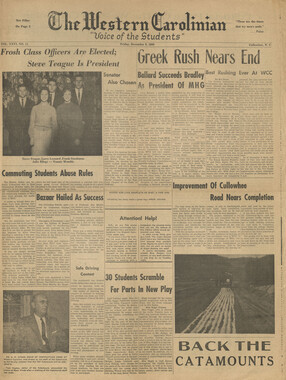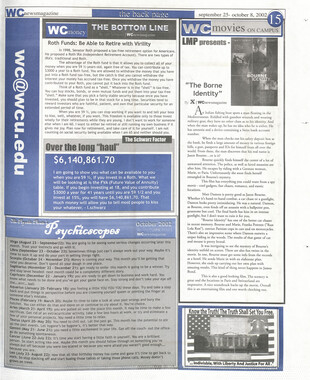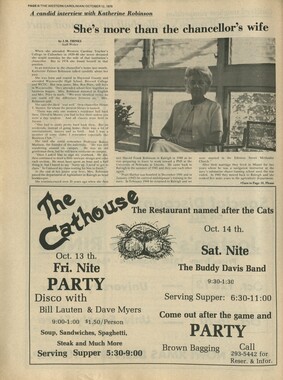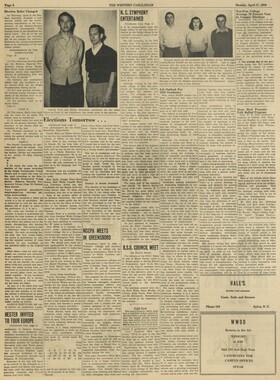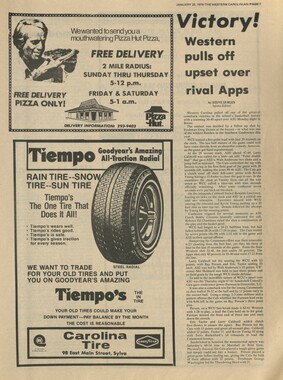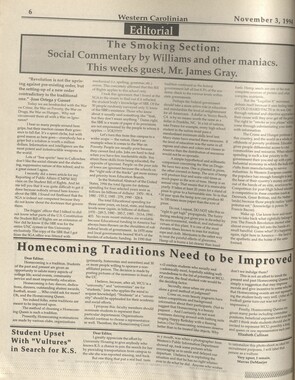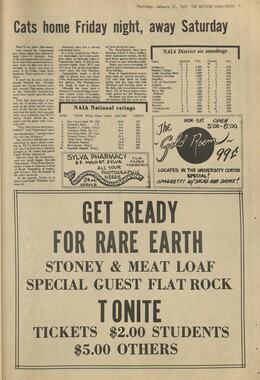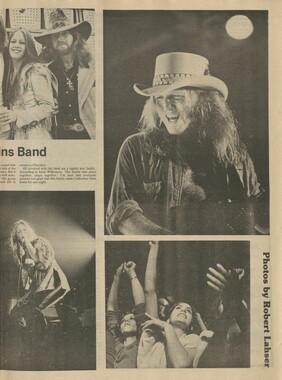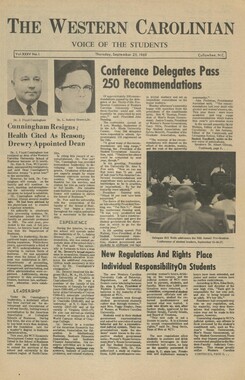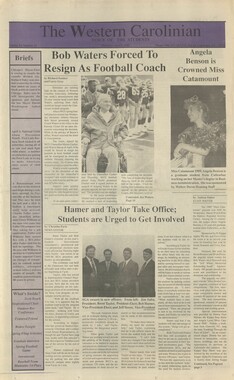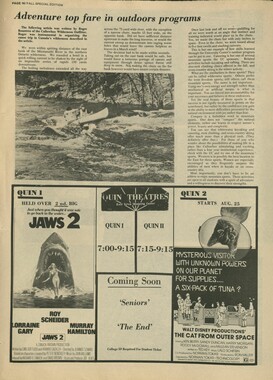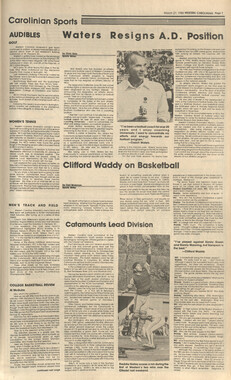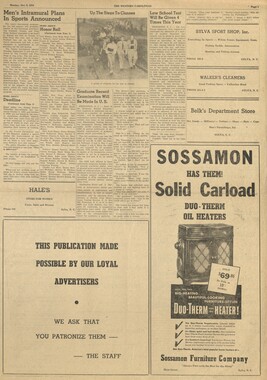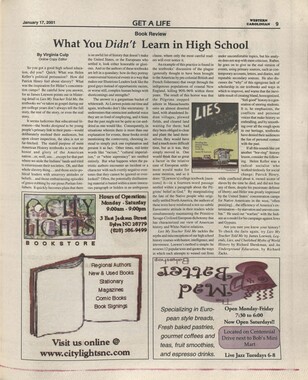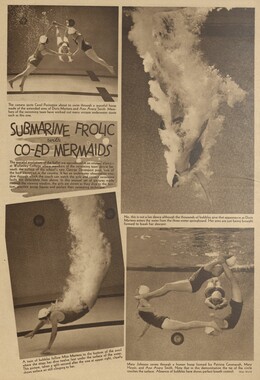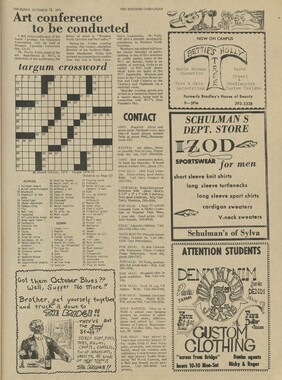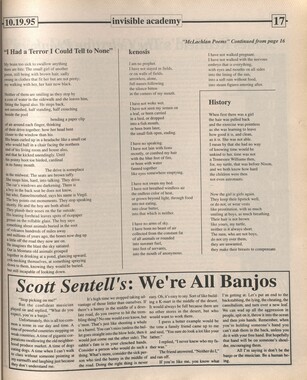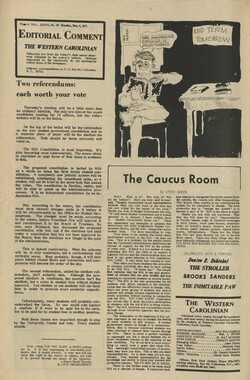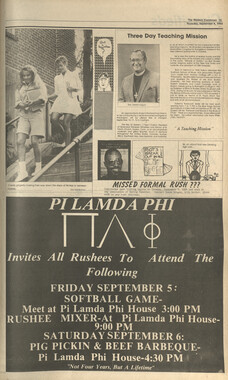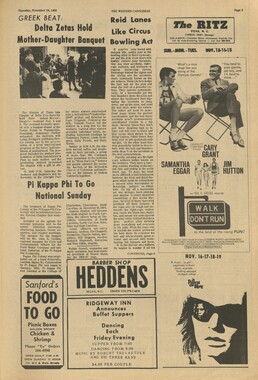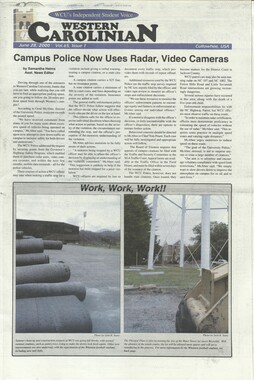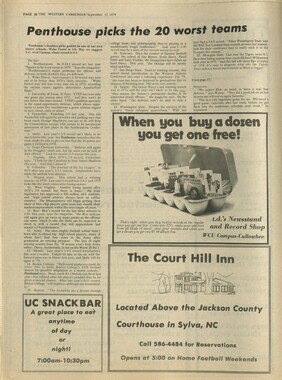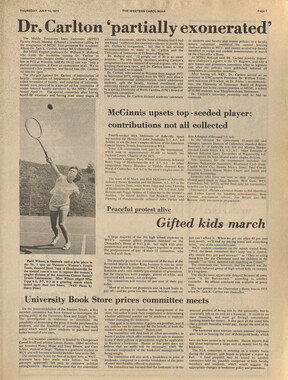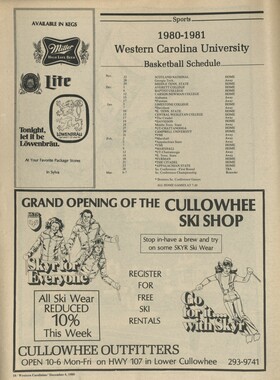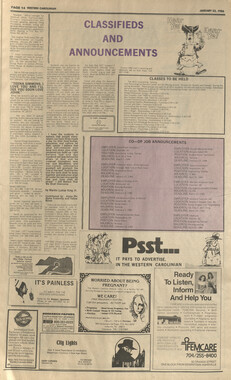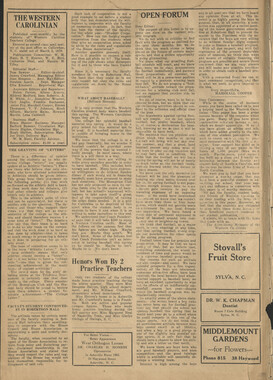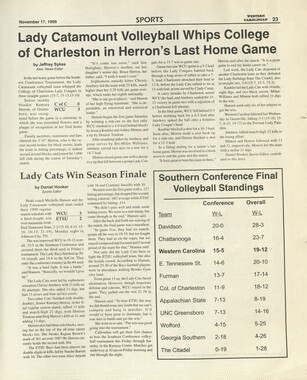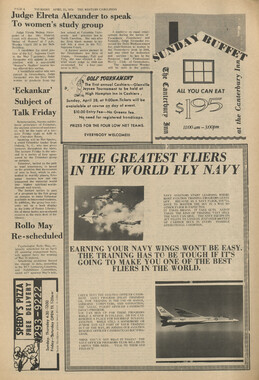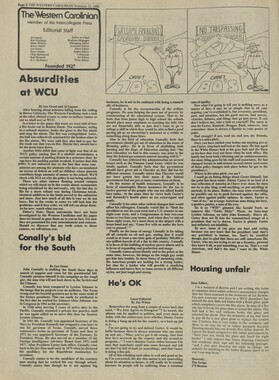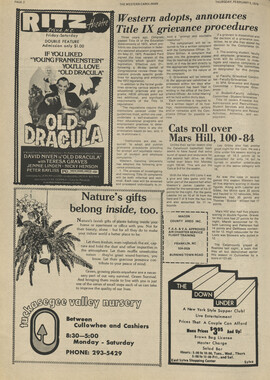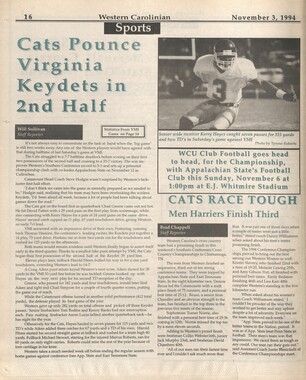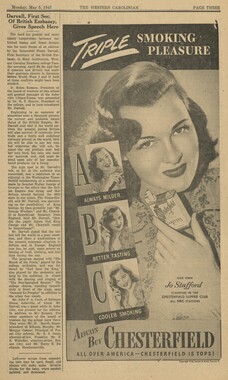Western Carolina University (20)
View all
- Canton Champion Fibre Company (2308)
- Cherokee Traditions (292)
- Civil War in Southern Appalachia (165)
- Craft Revival (1942)
- Great Smoky Mountains - A Park for America (2766)
- Highlights from Western Carolina University (430)
- Horace Kephart (941)
- Journeys Through Jackson (154)
- LGBTQIA+ Archive of Jackson County (85)
- Oral Histories of Western North Carolina (314)
- Picturing Appalachia (6772)
- Stories of Mountain Folk (413)
- Travel Western North Carolina (160)
- Western Carolina University Fine Art Museum Vitreograph Collection (129)
- Western Carolina University Herbarium (92)
- Western Carolina University: Making Memories (708)
- Western Carolina University Publications (2283)
- Western Carolina University Restricted Electronic Theses and Dissertations (146)
- Western North Carolina Regional Maps (71)
- World War II in Southern Appalachia (131)
University of North Carolina Asheville (6)
View all
- Allanstand Cottage Industries (62)
- Appalachian National Park Association (53)
- Bennett, Kelly, 1890-1974 (1388)
- Berry, Walter (76)
- Brasstown Carvers (40)
- Carver, George Washington, 1864?-1943 (26)
- Cathey, Joseph, 1803-1874 (1)
- Champion Fibre Company (233)
- Champion Paper and Fibre Company (297)
- Cherokee Indian Fair Association (16)
- Cherokee Language Program (22)
- Crowe, Amanda (40)
- Edmonston, Thomas Benton, 1842-1907 (7)
- Ensley, A. L. (Abraham Lincoln), 1865-1948 (275)
- Fromer, Irving Rhodes, 1913-1994 (70)
- George Butz (BFS 1907) (46)
- Goodrich, Frances Louisa (120)
- Grant, George Alexander, 1891-1964 (96)
- Heard, Marian Gladys (60)
- Kephart, Calvin, 1883-1969 (15)
- Kephart, Horace, 1862-1931 (313)
- Kephart, Laura, 1862-1954 (39)
- Laney, Gideon Thomas, 1889-1976 (439)
- Masa, George, 1881-1933 (61)
- McElhinney, William Julian, 1896-1953 (44)
- Niggli, Josephina, 1910-1983 (10)
- North Carolina Park Commission (105)
- Osborne, Kezia Stradley (9)
- Owens, Samuel Robert, 1918-1995 (11)
- Penland Weavers and Potters (36)
- Roberts, Vivienne (15)
- Roth, Albert, 1890-1974 (142)
- Schenck, Carl Alwin, 1868-1955 (1)
- Sherrill's Photography Studio (2565)
- Southern Highland Handicraft Guild (127)
- Southern Highlanders, Inc. (71)
- Stalcup, Jesse Bryson (46)
- Stearns, I. K. (213)
- Thompson, James Edward, 1880-1976 (226)
- United States. Indian Arts and Crafts Board (130)
- USFS (683)
- Vance, Zebulon Baird, 1830-1894 (1)
- Weaver, Zebulon, 1872-1948 (58)
- Western Carolina College (230)
- Western Carolina Teachers College (282)
- Western Carolina University (1794)
- Western Carolina University. Mountain Heritage Center (18)
- Whitman, Walt, 1819-1892 (10)
- Wilburn, Hiram Coleman, 1880-1967 (73)
- Williams, Isadora (3)
- Cain, Doreyl Ammons (0)
- Crittenden, Lorraine (0)
- Rhodes, Judy (0)
- Smith, Edward Clark (0)
- Appalachian Region, Southern (2569)
- Asheville (N.C.) (1923)
- Avery County (N.C.) (26)
- Blount County (Tenn.) (161)
- Buncombe County (N.C.) (1672)
- Cherokee County (N.C.) (283)
- Clay County (N.C.) (555)
- Graham County (N.C.) (233)
- Great Smoky Mountains National Park (N.C. and Tenn.) (519)
- Haywood County (N.C.) (3524)
- Henderson County (N.C.) (70)
- Jackson County (N.C.) (4694)
- Knox County (Tenn.) (25)
- Knoxville (Tenn.) (12)
- Lake Santeetlah (N.C.) (10)
- Macon County (N.C.) (420)
- Madison County (N.C.) (212)
- McDowell County (N.C.) (39)
- Mitchell County (N.C.) (132)
- Polk County (N.C.) (35)
- Qualla Boundary (981)
- Rutherford County (N.C.) (76)
- Swain County (N.C.) (2115)
- Transylvania County (N.C.) (270)
- Watauga County (N.C.) (12)
- Waynesville (N.C.) (84)
- Yancey County (N.C.) (72)
- Aerial Photographs (3)
- Aerial Views (60)
- Albums (books) (4)
- Articles (1)
- Artifacts (object Genre) (228)
- Bibliographies (1)
- Biography (general Genre) (2)
- Cards (information Artifacts) (38)
- Clippings (information Artifacts) (191)
- Crafts (art Genres) (622)
- Depictions (visual Works) (21)
- Design Drawings (1)
- Drawings (visual Works) (184)
- Envelopes (73)
- Facsimiles (reproductions) (1)
- Fiction (general Genre) (4)
- Financial Records (12)
- Fliers (printed Matter) (67)
- Glass Plate Negatives (381)
- Guidebooks (2)
- Internegatives (10)
- Interviews (815)
- Land Surveys (102)
- Letters (correspondence) (1013)
- Manuscripts (documents) (618)
- Maps (documents) (177)
- Memorandums (25)
- Minutes (administrative Records) (59)
- Negatives (photographs) (5835)
- Newsletters (1285)
- Newspapers (2)
- Occupation Currency (1)
- Paintings (visual Works) (1)
- Pen And Ink Drawings (1)
- Periodicals (193)
- Personal Narratives (10)
- Photographs (12976)
- Plans (maps) (1)
- Poetry (6)
- Portraits (4533)
- Postcards (329)
- Programs (documents) (151)
- Publications (documents) (2236)
- Questionnaires (65)
- Scrapbooks (282)
- Sheet Music (2)
- Slides (photographs) (402)
- Songs (musical Compositions) (2)
- Sound Recordings (796)
- Specimens (92)
- Speeches (documents) (15)
- Tintypes (photographs) (8)
- Transcripts (322)
- Video Recordings (physical Artifacts) (23)
- Vitreographs (129)
- Text Messages (0)
- A.L. Ensley Collection (275)
- Appalachian Industrial School Records (7)
- Appalachian National Park Association Records (336)
- Axley-Meroney Collection (2)
- Bayard Wootten Photograph Collection (20)
- Bethel Rural Community Organization Collection (7)
- Blumer Collection (5)
- C.W. Slagle Collection (20)
- Canton Area Historical Museum (2110)
- Carlos C. Campbell Collection (282)
- Cataloochee History Project (64)
- Cherokee Studies Collection (4)
- Daisy Dame Photograph Album (5)
- Daniel Boone VI Collection (1)
- Doris Ulmann Photograph Collection (112)
- Elizabeth H. Lasley Collection (1)
- Elizabeth Woolworth Szold Fleharty Collection (4)
- Frank Fry Collection (95)
- George Masa Collection (173)
- Gideon Laney Collection (452)
- Hazel Scarborough Collection (2)
- Hiram C. Wilburn Papers (28)
- Historic Photographs Collection (236)
- Horace Kephart Collection (861)
- Humbard Collection (33)
- Hunter and Weaver Families Collection (1)
- I. D. Blumenthal Collection (4)
- Isadora Williams Collection (4)
- Jesse Bryson Stalcup Collection (47)
- Jim Thompson Collection (224)
- John B. Battle Collection (7)
- John C. Campbell Folk School Records (80)
- John Parris Collection (6)
- Judaculla Rock project (2)
- Kelly Bennett Collection (1407)
- Love Family Papers (11)
- Major Wiley Parris Civil War Letters (3)
- Map Collection (12)
- McFee-Misemer Civil War Letters (34)
- Mountain Heritage Center Collection (4)
- Norburn - Robertson - Thomson Families Collection (44)
- Pauline Hood Collection (7)
- Pre-Guild Collection (2)
- Qualla Arts and Crafts Mutual Collection (12)
- R.A. Romanes Collection (681)
- Rosser H. Taylor Collection (1)
- Samuel Robert Owens Collection (94)
- Sara Madison Collection (144)
- Sherrill Studio Photo Collection (2558)
- Smoky Mountains Hiking Club Collection (616)
- Stories of Mountain Folk - Radio Programs (374)
- The Reporter, Western Carolina University (510)
- Venoy and Elizabeth Reed Collection (16)
- WCU Gender and Sexuality Oral History Project (32)
- WCU Mountain Heritage Center Oral Histories (25)
- WCU Oral History Collection - Mountain People, Mountain Lives (71)
- WCU Students Newspapers Collection (1744)
- Western North Carolina Tomorrow Black Oral History Project (69)
- William Williams Stringfield Collection (2)
- Zebulon Weaver Collection (109)
- African Americans (390)
- Appalachian Trail (35)
- Artisans (521)
- Cherokee art (84)
- Cherokee artists -- North Carolina (10)
- Cherokee language (21)
- Cherokee pottery (101)
- Cherokee women (208)
- Church buildings (170)
- Civilian Conservation Corps (U.S.) (110)
- College student newspapers and periodicals (1830)
- Dams (107)
- Dance (1023)
- Education (222)
- Floods (61)
- Folk music (1015)
- Forced removal, 1813-1903 (2)
- Forest conservation (220)
- Forests and forestry (1184)
- Gender nonconformity (4)
- Great Smoky Mountains National Park (N.C. and Tenn.) (181)
- Hunting (38)
- Landscape photography (25)
- Logging (118)
- Maps (83)
- Mines and mineral resources (8)
- North Carolina -- Maps (18)
- Paper industry (38)
- Postcards (255)
- Pottery (135)
- Railroad trains (71)
- Rural electrification -- North Carolina, Western (3)
- School integration -- Southern States (2)
- Segregation -- North Carolina, Western (5)
- Slavery (5)
- Sports (452)
- Storytelling (244)
- Waterfalls -- Great Smoky Mountains (N.C. and Tenn.) (66)
- Weaving -- Appalachian Region, Southern (280)
- Wood-carving -- Appalachian Region, Southern (328)
- World War, 1939-1945 (173)
Western Carolinian Volume 65 (66) Number 05
Item
Item’s are ‘child’ level descriptions to ‘parent’ objects, (e.g. one page of a whole book).
-
-
western Carolinian ?e September 20, 2000 WCU Design Student Strives to Change Face of Commercial Art Holly Rhodarmer Features Editor The only art many people are exposed to is commercial art. Billboards, advertisements and commercials bombard the senses. The need to inject a fine art sensibility into this medium is tremendous. The graphic design program strives to produce students of the highest caliber, with the capabilities necessary to succeed in this highly competitive field-as well as a firm understanding of the principles of aesthetics. Nathan Atwood, a senior from Wilkcsboro, has fine tuned his skills in the design program here at Western. This past summer he was able to apply what he had learned by working as an intern with Synergy Ad Group of Hickory. Much of his time was devoted to major company projects. He worked with Piedmont Pathology Associates, and his design was chosen to serve as their official letterhead. He also worked with Neanderthal Genius, a local magazine. When Atwood first came to Western he planned to study fine art. He soon realized that graphic design would be more likely to provide a steady paycheck. After taking Advanced Graphic Design, with professor Ion Jicha, he realized his two interests were not that far removed. photo by Elizabeth Barnes Nathan Atwood with his portfolio It was in Advanced Graphic Design that Atwood committed to the Design field. "I dedicated myself to this new medium of design,"he commented. "The class allowed for personal expression, and I realized how much room there was for artistic growth." Most design courses require at least four major projects a semester. Projects are printed at the print shop on campus and then critiqued by students and faculty. ___ J piano oy r.ll..tll'C Though design Aerosmith poster designed by Atwood leans heavily on visual competency, its base, and tools, are found in the mastery of computer programs. Design students learn Quark Express, Adobe Photoshop and Illustrator. Atwood cites British designer I o n a t h o n Barnbrook as his largest influence. Barnbrook is a contemporary designer who is known for his work in innovated typography. Barnbrook's work is often showcased in the magazine Emigre. After graduation Atwood plans to go to Nashville to work for a music magazine. His talent and vision will serve him well in this rigorous field. He comments that his main field of work is, "in a commercial format from magazine layout, promotional posters to CD covers- but I hope to apply design that makes viewers look at the subject in a new way." photo by Elizabeth Barnes — ,j— ... „ WCU Graduate Student Shines as Playwright Kw Mnliffro fliMf D.......— :„ C a i ii tw. by Melissa Dills Staff Writer Students often attend various theatre productions during the course of the school year. But how many of us have ever considered how difficult it would be to write a play? One WCU grad student has demonstrated her own creative talents in the field of drama when her play was selected as a winner in an undergraduate playwriting contest. Brittany Bremer graduated last December from the University of North Carolina at Charlotte where she earned her undergraduate degree in English. Her interests in the field are play writing and creative writing. So what brought about her winning play? "It all started my freshman year," said Bremer," when a creative writing instructor pointed out that the characters in my poetry were so well-developed that I should try playwriting." Bremer is from Asheville, NC, and now resides in Sylva. She is enrolled at WCU and is currently seeking her Masters in English. While attending UNCC, she found herself initially frightened when she signed up for a course in playwriting. The professor challenged the class with the task of completing an entire play during the semester. The pressure was more acutely felt when she realized her entire grade depended on finishing the project. "I learned to write plays by writing a little bit at a time," said Bremer, " by going to class, and watching others act out scenes." By the end of the semester, her play was complete and she laid it aside. She assumed that it would never come to her attention again. Until one day she received an email from her playwriting instructor informing her of a playwriting contest sponsored by the theatre department. He suggested she submit her play. "The contest was essentially for the atre playwrights," Bremer said. " It was to give the theatre students a chance to exhibit their talents." The selected winners of the contest would be given the opportunity to have their plays read in a showcase. Bremer felt apprehensive at being up against theatre students. Several weeks later, however, she received a phone call with the good news that she had been selected as a winner. The department loved her play. Now the question arises, what was the play about? The basic inspiring idea came from a time when she studied abroad. Bremer said, "During the 1995-% school year, I was a Rotary exchange student in Pecs, Hungary, which is located about 20 miles from Croatia." Her trip provided her with a rich and crazy variety of people that she could later weave into her play. One elderly woman in particular captured her imagination. The woman, a bag lady, carried herself in a manner that hinted that she might have once been a great woman until a tragic turn of events had left her in her present state. She finally approached the woman and asked her about her past. "The lady had once been a professional whistler in vaudeville," Btc™" said, " but since she was a Jew, she ha been deported to Auschwitz. What happened to her remains a mystery, but I left her traumatized." This conversation stayed imprinted in Bremer's memory. When she was give the task to write a play, she knew who s wanted to write about. Two years later'.Sce had used her imagination to create, pieC by piece, the life of this woman in nerPlaJr With a first complete play under belt, Bremer is presently working on second play featuring the myth of UH • » firct wile in who was supposedly Adam s nrsi the Garden of Eden. She hopes to adap to a more modern time setting. Bremer's other hobbies include m^ ing dolls and embroidery. She also joys surfing the net.
Object
Object’s are ‘parent’ level descriptions to ‘children’ items, (e.g. a book with pages).
-
The Western Carolinian is Western Carolina University's student-run newspaper. The paper was published as the Cullowhee Yodel from 1924 to 1931 before changing its name to The Western Carolinian in 1933.
-
